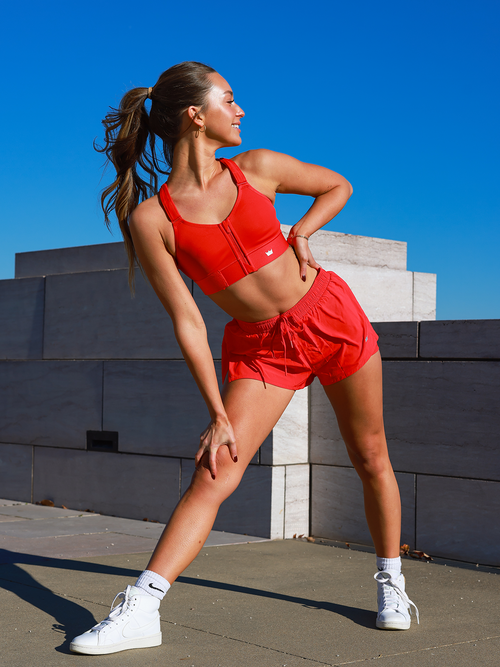FREE STANDARD SHIPPING ON ORDERS OVER $99
Your Guide to Mastering L-Sit Pull-Ups with Baby Steps
Pull-ups are perhaps the most challenging bodyweight exercise to master. You have to lift your entire body using only your arm and back muscles. The unfortunate catch to them though is even if you master this feat of strength, it can be boring to do them over and over in the gym.
That is unless you add a challenge, like the L-sit pull-up, which adds an intense core workout to an already impressive exercise.
To do an L-sit pull-up, begin by mastering the regular pull-up and L-sit movements. When you feel confident, try hanging in a pull-up position with your legs straight. Then, you can do flutter kicks from the position. After that, do L-sit pull-ups with one leg before adding the second leg.
As with many fitness goals, you’ll have to take small steps to achieve an L-sit pull-up. It requires supreme strength in the core, back, and arm muscles. By setting smaller goals for yourself, you can build strength over time until you’re ready for the full movement.
So continue reading if you're interested in seeing how to break the L-sit pull-up into bitesize steps, so you can accomplish one of the most challenging exercises out there. We'll also show you why L-sit pull-ups are worth the effort.
What's So Great About L-Sit Pull-Ups?
At first glance, pull-ups aren’t the most “functional” strength exercise. In your day-to-day life, it’s unlikely that you’ll ever need to do a similar overhead pulling movement unless you’re a rock climber or Spiderman. It’s also a rarely-used movement in sports.
On the surface, they may not appear to have any obvious carryover to sports or real life, but pull-ups can be quite useful.
If you’re a tennis player or boxing enthusiast, pull-ups help you transfer energy from your legs into your arms by strengthening the muscles surrounding the shoulder.
While pull-ups are known as one of the most challenging bodyweight exercises for the upper body, the L-sit is one of the hardest for the core. Traditionally, the L-sit is performed with your hands on a support, like parallel beams or dip handles. You've most certainly seen gymnasts in this pose during the Olympics.
Instead of doing a standard pull-up, adding the L-sit component means once you grab the bar with your hands, you’ll extend your legs in front of your body, holding them off the ground, while supporting your body weight with your arms. As you can imagine, very few core exercises are harder.
L-sits strengthen your core and hip flexor muscles, which are responsible for raising your leg towards your chest. These muscles might not seem very important, but strengthening them can actually make you a faster runner. As you run, you’re constantly driving your knees forward and up. Doing so more forcefully can improve your sprint speed.
Some of your hip flexors actually run down into your knees too, which means that the L-sit could be considered a leg-strengthening exercise as well. Plus, since it works your core, it can give your abs more definition.
Why Are L-Sit Pull-Ups So Much Harder?
When you do an L-sit pull-up, you’re basically doing two very advanced bodyweight training exercises at the same time, which is why many trainers recommend working on each part of the movement separately.
L-sit pull-ups combine the upper body and core strengthening of each movement into one extremely challenging exercise, which is why we'll go a bit further and show you all the muscles involved.
What Muscles do L-Sit Pull-Ups Work?
It’s easier to break the L-sit and pull-up into two different parts to see what muscles they work. The general concept to keep in mind though is the pull-up targets the back and arms, whereas the L-sit is more for the core and legs. You’ll need to strengthen all of these muscles to master the L-sit pull-up.
Muscles Worked with Pull-Ups
Pull-ups are performed with your palms facing away from your body. They’re slightly different from chin-ups, which point the palms toward your body. There are a number of muscles that the pull-up works.
- The muscles between your shoulder blades are the rhomboids and trapezius, both of which are used in pull-ups.
- Closer to your armpit is the teres major, which connects your shoulder blade to the top of your arm bone.
- Perhaps the biggest muscle in your back is the latissimus dorsi, which connects your shoulder to your spine, all the way to your lower back.
- Both the triceps and biceps are working as you do pull-ups.
- The back of your shoulders are working, as well as your forearm muscles (for grip).
- You even use your chest muscles a little, as well as the lower back muscles.
If you're looking for some new ideas on upper body exercises, look no further than SHEFIT's 5 Best Compound Movements for a Toned Upper Body.
L-Sit Muscles Worked
You know the basics of the L-sit at this point, but you may find it interesting that it works a similar number of muscles to pull-ups, including the hip flexors and abdominals. Here's a look at every muscle that gets engaged in the exercise.
- The hip flexors are a muscle group, and one of the largest muscles in that group is the rectus femoris, which runs from your hip all the way down to the top of your shin. It flexes both your hip and knee.
- Your quadriceps, which are the muscles in the front of your thigh, have to work to keep your knees straight, which is part of the correct technique for L-sits.
- In your trunk, the rectus abdominis and oblique muscles are all working to hold your legs in the air and stabilize your hips. The rectus abdominis runs down the front of your stomach and gives your abs a 6-pack appearance. The obliques run down the sides of your torso.
- Also in the trunk are more hip flexor muscles, including the iliopsoas, which run from your lower back into your hip joint. This muscle helps lift your legs and keep them elevated throughout the movement.
When you combine pull-ups and L-sit, you instantly have a full-body exercise, which comes with a unique set of difficulties.
How to Master Each Movement of an L-Sit Pull-Up
You have two options here. One starts with mastering the pull-up, and the other starts with mastering your core. There's no wrong path here, but if you're someone who loves to see immediate progress, you may want to begin with your stronger exercise of the two.
Option 1: Starting with the Pull-Up
To strengthen your back muscles, arm muscles, core, and hip flexors at the same time, work your way up to doing L-sit pull-ups. Once you’re pretty comfortable with pull-ups and have a strong core, it’s time to start piecing both body parts together.
Begin by mastering your pull-up. If you’re not comfortable doing multiple sets or reps yet, you can use assistance exercises to improve your strength and technique. Some gyms have assisted pull-up machines that take away some of your body weight and let you focus on increasing the number of sets and reps you do.
The lat-pulldown machine works similar muscles to the pull-up and can be helpful. If you use this machine, try doing pulldowns with a grip similar to the one you’re using for pull-ups.
In general, you’ll want your hands about shoulder-width apart and palms facing forwards.
Adding the L-Sit
For the L-sit, you can start by using parallel bars.
These are plastic or metal bars that sit anywhere from half a foot to multiple feet above the ground. Set the bars next to your body, put your hands on them, and press your butt off the ground. Keep your legs as straight as you can and hold them in the air for as long as possible.
You can also start in a seat, put your hands on either side of the seat, and press your butt off the chair to practice.
Over time, you'll want to gradually transition into straightening your legs while in the L-sit position. As you get stronger, you’ll be able to hold them straighter for longer.
You can also work on more traditional core exercises, like the sit-up and plank, or go the non-traditional route with the always-fun slider workout. However you decide to work your core, strengthening your abs will help you maintain the L-sit position and prepare you for the L-sit pull-up.
Option 2: Starting with the Core
Many trainers recommend easing into an L-sit with a few different exercises, such as the hanging leg raise. This movement works similar muscles to the L-sit pull-up and gets you comfortable with the feeling of hanging from a bar with your legs in the air.
To do the hanging leg raise, hold the pull-up bar and flex your quads to straighten your knees. Lift your legs straight in front of your body, then slowly lower them. Repeat up to 10 times.
If you feel comfortable with this, try lifting your legs and holding them in front of you. Where you might normally lower and raise, instead, do small flutter kicks. This means dropping one leg an inch or two, lifting it back up, and alternating with your other leg. Do this rapidly for as long as you can.
Once you’re comfortable with these L-sit pull-up variations, it’s time to add a pull-up.
Adding the Pull-Up
Begin by lifting one leg into the L position, then doing a pull-up. You can either keep that leg up for the next rep or switch legs. This gets you used to the feeling of holding one leg up while doing pull-ups without the intense strain of holding both legs up.
When you do an L-sit pull-up, it’s an intense challenge because gravity pulls your legs down as you move up. Not only are you straining your upper body muscles to pull, but you also need to keep your legs stable.
By following the progressions above, you can ease into the movement.
Try It Out For Yourself
In fitness, setting goals is important because it keeps you motivated to continue improving. The L-sit pull-up is a goal that might seem daunting but will make you feel unstoppable once you achieve it.
To get to the point where you can confidently do L-sit pull-ups, you’ll need to strengthen your back and arm muscles. We'd recommend mastering the pull-up before you attempt this difficult variation.
You’ll also need to improve your L-sit and strengthen your core muscles and hip flexors. When you feel confident, try some of the variations mentioned above to ease yourself into the L-sit pull-up. Once you can do them comfortably, feel free to show them off in the gym or with your friends - you've certainly earned the right!















